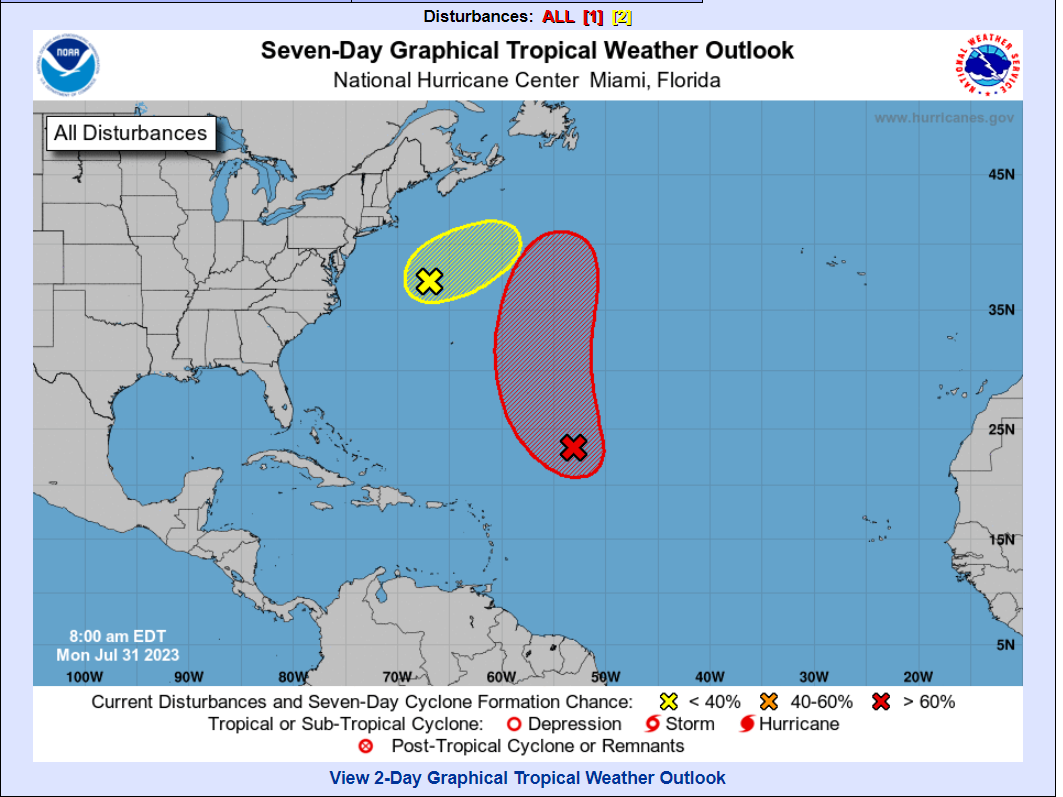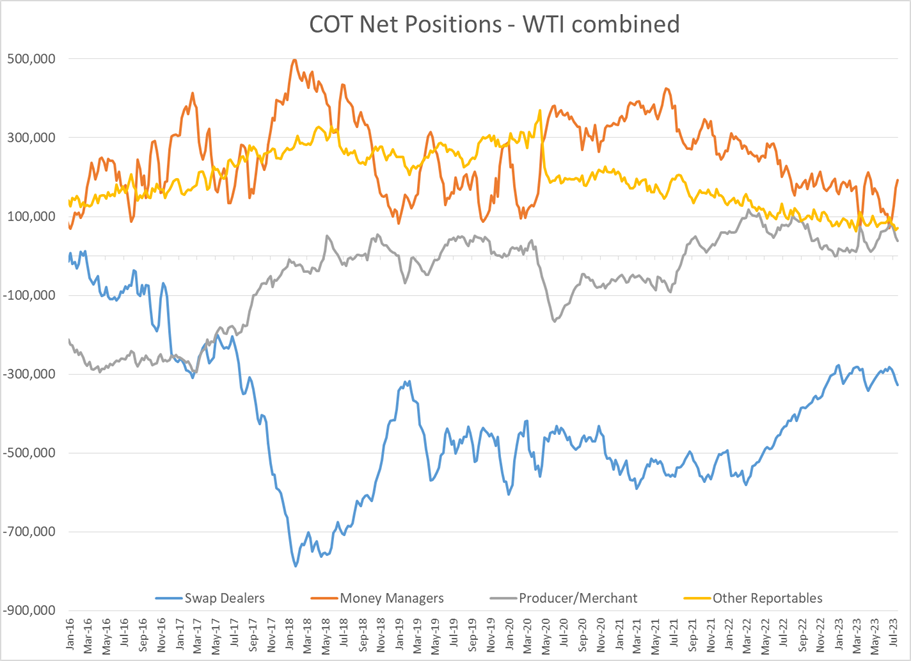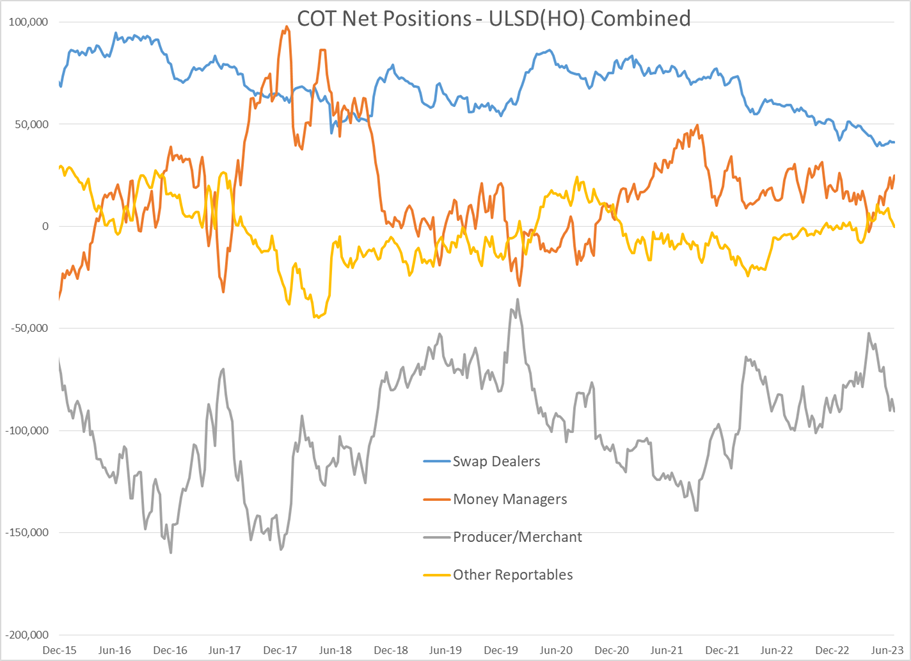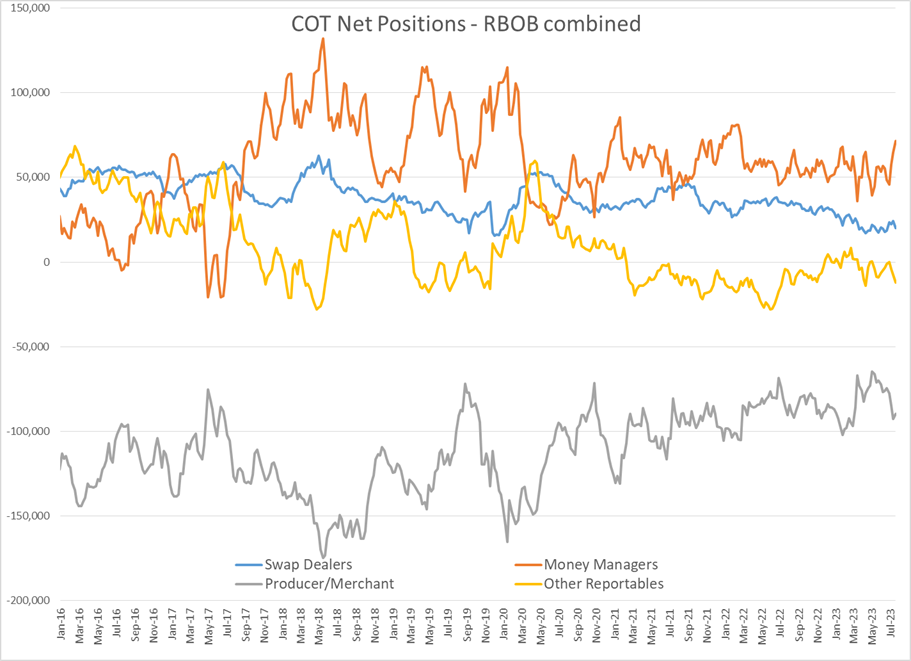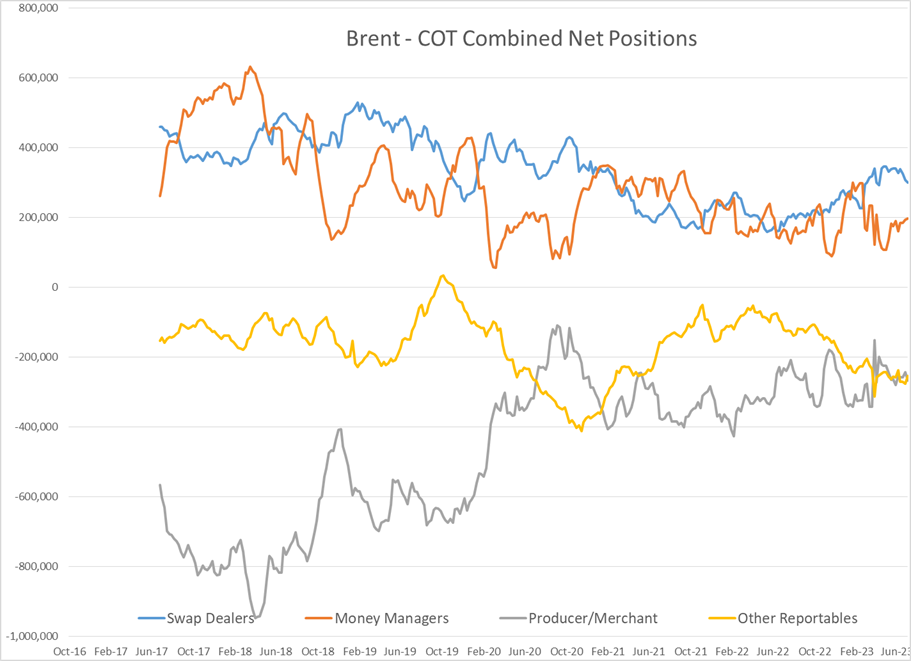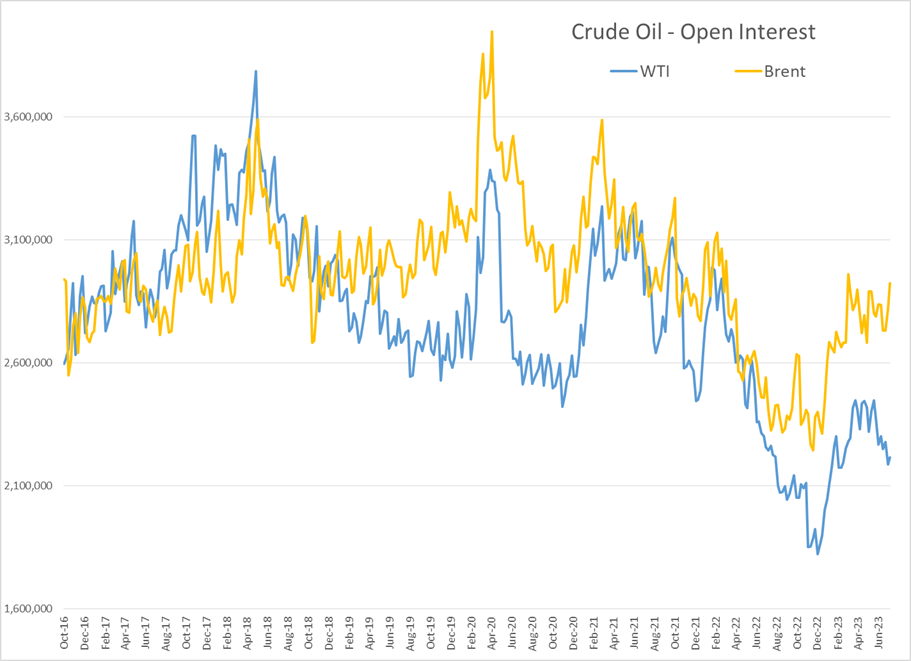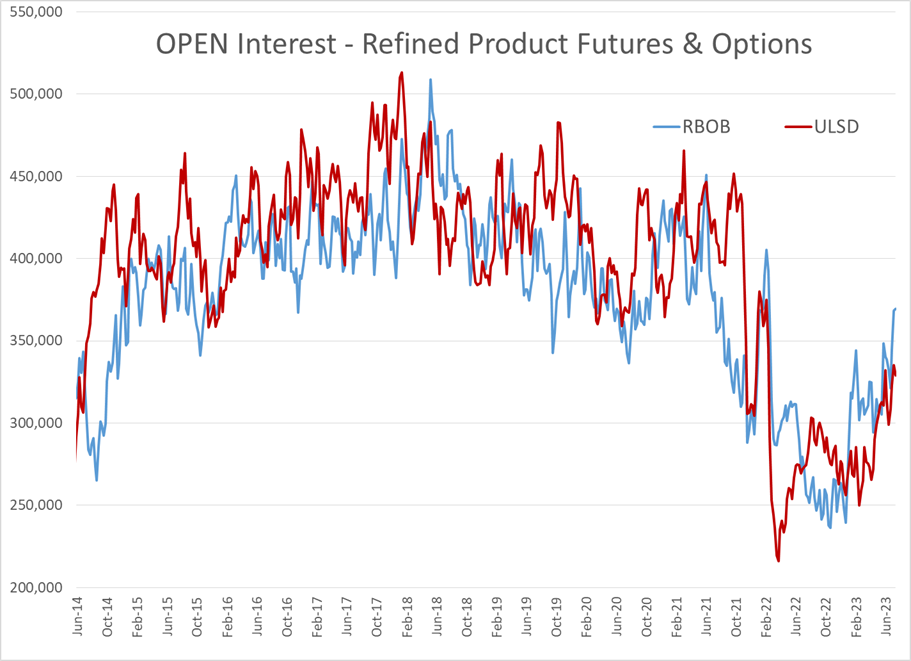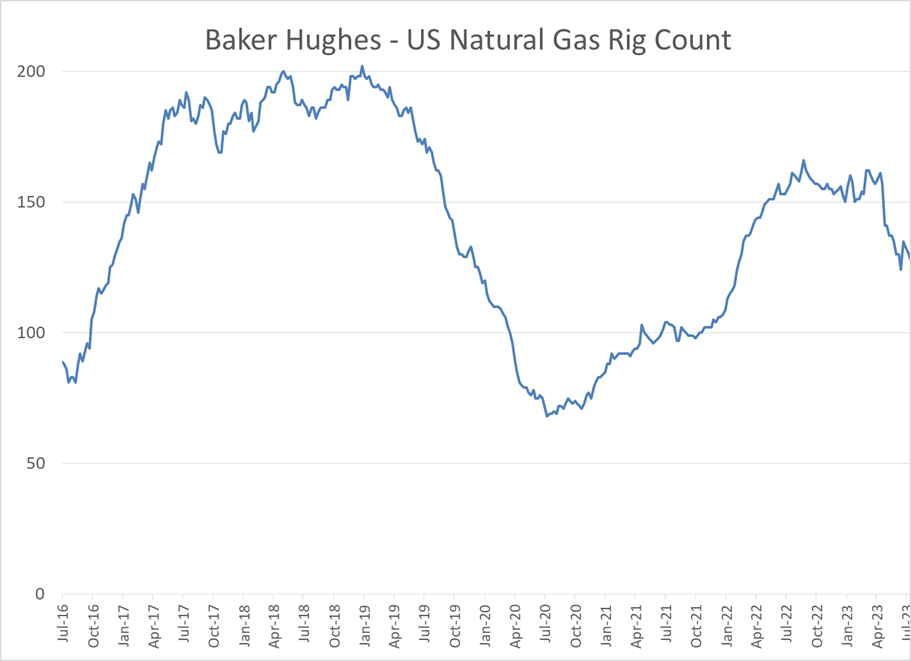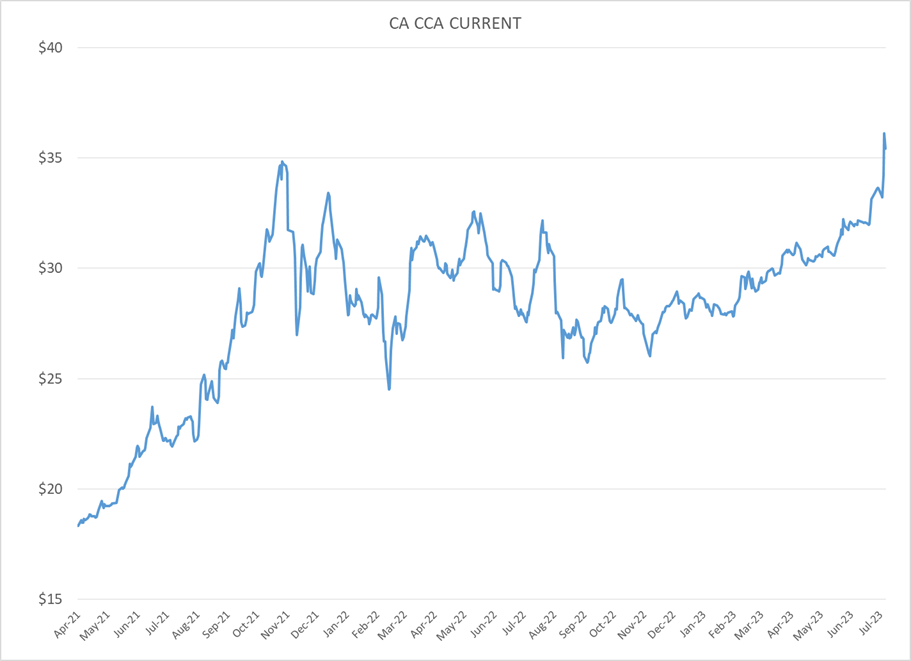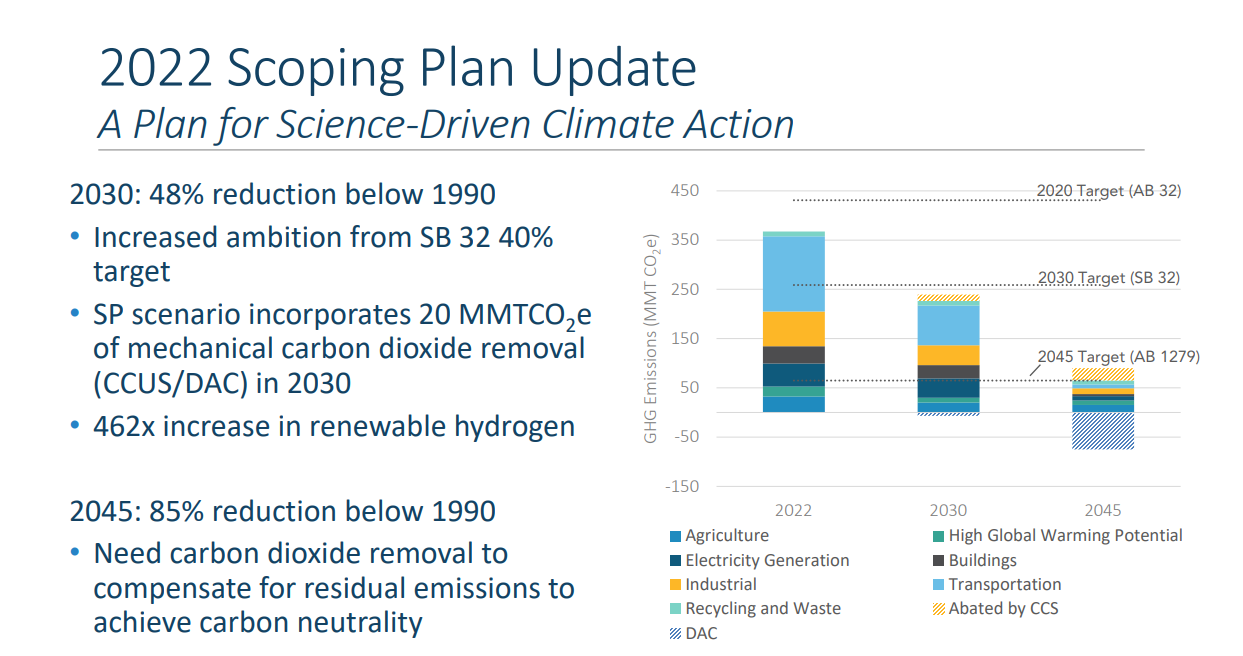Refined Products Are Trading Down A Couple Of Cents In The Early Going While Crude Oil Contracts Are Seeing Modest Gains As July Trading Comes To A Close

Refined products are trading down a couple of cents in the early going while crude oil contracts are seeing modest gains as July trading comes to a close, in what should end up being the strongest month in almost a year for energy contracts.
RBOB gasoline futures came within 65 points of reaching the $3/gallon mark Friday, before stalling out and pulling back to around $2.93 this morning. The July contract expires today, and August is trading more than 6 cents lower, reducing the chances of another run at $3 gasoline futures near term, while physical prices across the 3 West Coast spot markets are all well above that level. Most cash markets are already trading vs August futures, so watch that contract for price direction today if you’re not already.
ULSD futures topped out at $2.9748 Friday before sliding to around $2.93 this morning but aren’t seeing anywhere near the backwardation of gasoline (another sign of the dramatic changes from a year ago) and the charts suggest a decent chance diesel futures can still make a run at $3 over the next several days. Just like gasoline, west coast ULSD spot markets are all trading north of $3, while markets east of the Rockies range from $2.86-$2.95 this morning.
Money managers continue to jump on the energy bandwagon, adding length across the board last week in crude and refined products. The net length (bets on higher prices) for RBOB and ULSD is at the highest level of the year, with the late-comers still willing to buy after the strong July rally. From a historical perspective, the outstanding length held by the big speculators is relatively mild, so it’s not yet a contrary indicator that the trend may soon run out of steam.
Open interest continues to recover in RBOB ULSD and Brent contracts as easing volatility and margin requirements encourage funds to return to the market after many were forced out during last year’s chaos. The exception to the OI recovery rule is WTI, which is still running roughly ½ million contracts lower than anything we saw from 2016-2021.
The reason for the slump in the classic NYMEX crude oil contract appears to be the rapid expansion in trading activity for new WTI contracts FOB Houston and Midland as the export market for domestic crude grades increases. Both the CME Group (NYMEX parent) and ICE (Home of the Brent contract) are racing to take advantage of the changing patterns, and both exchanges have reported record trading activity in their new WTI contracts over the past week.
Baker Hughes reported a drop of 1 oil rig and 3 natural gas rigs drilling in the US last week, continuing the trend of slow but steady attrition in the rig count that’s been happening for most of the year. Unlike the past 3 weeks however, the Permian basin didn’t lead the slide, and actually increased by 1 rig on the week. Don’t expect a rapid recovery in rig counts with oil prices north of the $80 mark given the long lead times needed to acquire equipment and crews, but we may see the declines come to an end if prices can hold near current levels.
California Carbon Allowance (CCA) prices spiked to a record high last week after the Air Resources Board (CARB) announced plans to make the Cap & Trade program more stringent. California’s Low Carbon Fuel Standard (LCFS) credit values meanwhile continue to languish as new production of renewables, most notably renewable diesel, creates a surplus off credits and the state’s plans to also make that program more stringent are less clear.
The National Hurricane center is tracking two potential storm systems in the Atlantic this week, one of which is given 80% odds of being named, while the other has just 20%. Both systems look like they’ll stay far enough out to sea to not be a threat to land, while the map suggests they could end up merging off the coast of New England. Two storm systems converging off of the New England coast…seems oddly familiar.
Click here to download a PDF of today's TACenergy Market Talk.
News & Views
View All
The Recovery Rally In Energy Markets Continues For A 3rd Day
The recovery rally in energy markets continues for a 3rd day with refined product futures both up more than a dime off of the multi-month lows we saw Wednesday morning. The DJIA broke 40,000 for the first time ever Thursday, and while it pulled back yesterday, US equity futures are suggesting the market will open north of that mark this morning, adding to the sends of optimism in the market.
Despite the bounce in the back half of the week, the weekly charts for both RBOB and ULSD are still painting a bearish outlook with a lower high and lower low set this week unless the early rally this morning can pick up steam in the afternoon. It does seem like the cycle of liquidation from hedge funds has ended however, so it would appear to be less likely that we’ll see another test of technical support near term after this bounce.
Ukraine hit another Russian refinery with a drone strike overnight, sparking a fire at Rosneft’s 240mb/day Tuapse facility on the black sea. That plant was one of the first to be struck by Ukrainian drones back in January and had just completed repairs from that strike in April. The attack was just one part of the largest drone attack to date on Russian energy infrastructure overnight, with more than 100 drones targeting power plants, fuel terminals and two different ports on the Black Sea. I guess that means Ukraine continues to politely ignore the White House request to stop blowing up energy infrastructure in Russia.
Elsewhere in the world where lots of things are being blown up: Several reports of a drone attack in Israel’s largest refining complex (just under 200kbd) made the rounds Thursday, although it remains unclear how much of that is propaganda by the attackers and if any impact was made on production.
The LA market had 2 different refinery upsets Thursday. Marathon reported an upset at the Carson section of its Los Angeles refinery in the morning (the Carson facility was combined with the Wilmington refinery in 2019 and now reports as a single unit to the state, but separately to the AQMD) and Chevron noted a “planned” flaring event Thursday afternoon. Diesel basis values in the region jumped 6 cents during the day. Chicago diesel basis also staged a recovery rally after differentials dropped past a 30 cent discount to futures earlier in the week, pushing wholesale values briefly below $2.10/gallon.
So far there haven’t been any reports of refinery disruptions from the severe weather than swept across the Houston area Thursday. Valero did report a weather-related upset at its Mckee refinery in the TX panhandle, although it appears they avoided having to take any units offline due to that event.
The Panama Canal Authority announced it was increasing its daily ship transit level to 31 from 24 as water levels in the region have recovered following more than a year of restrictions. That’s still lower than the 39 ships/day rate at the peak in 2021, but far better than the low of 18 ships per day that choked transit last year.
Click here to download a PDF of today's TACenergy Market Talk.

Energy Prices Found A Temporary Floor After Hitting New Multi-Month Lows Wednesday
Energy prices found a temporary floor after hitting new multi-month lows Wednesday morning as a rally to record highs in US equity markets and a modestly bullish DOE report both seemed to encourage buyers to step back into the ring.
RBOB and ULSD futures both bounced more than 6 cents off of their morning lows, following a CPI report that eased inflation fears and boosted hopes for the stock market’s obsession of the FED cutting interest rates. Even though the correlation between energy prices and equities and currencies has been weak lately, the spillover effect on the bidding was clear from the timing of the moves Wednesday.
The DOE’s weekly report seemed to add to the optimism seen in equity markets as healthy increases in the government’s demand estimates kept product inventories from building despite increased refinery runs.
PADD 3 diesel stocks dropped after large increases in each of the past 3 weeks pushed inventories from the low end of their seasonal range to average levels. PADD 2 inventories remain well above average which helps explain the slump in mid-continent basis values over the past week. Diesel demand showed a nice recovery on the week and would actually be above the 5 year average if the 5% or so of US consumption that’s transitioned to RD was included in these figures.
Gasoline inventories are following typical seasonal patterns except on the West Coast where a surge in imports helped inventories recover for a 3rd straight week following April’s big basis rally.
Refiners for the most part are also following the seasonal script, ramping up output as we approach the peak driving demand season which unofficially kicks off in 10 days. PADD 2 refiners didn’t seem to be learning any lessons from last year’s basis collapse and rapidly increased run rates last week, which is another contributor to the weakness in midwestern cash markets. One difference this year for PADD 2 refiners is the new Transmountain pipeline system has eroded some of their buying advantage for Canadian crude grades, although those spreads so far haven’t shrunk as much as some had feared.
Meanwhile, wildfires are threatening Canada’s largest oil sands hub Ft. McMurray Alberta, and more than 6,000 people have been forced to evacuate the area. So far no production disruptions have been reported, but you may recall that fires in this region shut in more than 1 million barrels/day of production in 2016, which helped oil prices recover from their slump below $30/barrel.
California’s Air Resources Board announced it was indefinitely delaying its latest California Carbon Allowance (CCA) auction – in the middle of the auction - due to technical difficulties, with no word yet from the agency when bidders’ security payments will be returned, which is pretty much a nice microcosm for the entire Cap & Trade program those credits enable.

